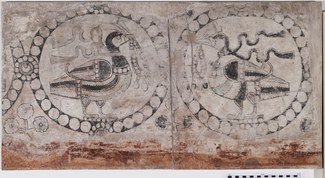Journal of Inner Asian Art and Archaeology publishes sixth volume
In 1995, several enterprising graduate students in the Department of Art and Archaeology at the School of Oriental and African Studies (SOAS), University of London, founded the Circle of Inner Asian Art (CIAA) to serve as a forum for discussion and exchange of information about the non-Islamic art and archaeology of Inner Asia. The Circle hosted lectures by internationally renowned scholars, as well as seminars and workshops; it promoted exchange of information regarding Inner Asian art and archaeology through an international network of universities, museums, and other organizations. Probably its most important—and certainly most lasting—contribution was its Newsletter, produced three times a year. It featured short articles and excavation reports by various scholars, a “News Bulletin” on recent and upcoming international events, awards, and exhibitions, in addition to conference reports and listings, and descriptive notices of forthcoming publications, often accompanied by brief reviews.
Graduate students eventually earn their degrees and move on to another stage of life and to other climes. But one of the original group, now Dr. Lilla Russell-Smith, wished to preserve the mission of this unique publication and interested the Belgian publisher, Brepols, in launching the annual Journal of Inner Asian Art and Archaeology. It was my good fortune to be asked by Lilla to co-edit volume 1 (2006), which was mostly devoted to articles focusing on Iran and neighboring areas in celebration of the 80th birthday of A. D. H. Bivar, Professor of Iranian Studies at SOAS, and, among his many accolades, Honorary President of the CIAA. Similarly, volume 2 (2007) contained a large festschrift section devoted to more eastern subjects to honor Roderick Whitfield, Professor of Chinese Art and Archaeology at SOAS, and President of the CIAA. As begun with these volumes, the JIAAA attempts to balance the “West Central Asian” world with the “East Central Asian” one, with a range of articles for widest appeal, not only on art and archaeology but on the related areas of language and history.
With Lilla’s appointment as Curator of Central Asian Collections in the Museum of Asian Art, Berlin, and my association with ISAW, first as a Visiting Research Scholar and now as a Research Associate, we thought it would be a good idea for the Journal to come under ISAW’s wings. Fortunately, ISAW’s director, Roger Bagnall, did too. Another reason for making the JIAAA an ISAW enterprise was to benefit from the involvement of Sören Stark, Assistant Professor of Central Asian Art and Archaeology; beginning with volume 4, Sören has been sharing the editorship with us.
Volume 6 will soon be published; we invite readers to visit http://isaw.nyu.edu/publications/jiaaa to see its Table of Contents and images from some of the articles. With volume 7, Lilla Russell-Smith will be stepping back from co-editing but will remain on our Editorial Board. Taking her place will be Annette L. Juliano, Professor of Chinese Art History at Rutgers University-Newark.
Soon we expect to add to the JIAAA webpage the complete contents of volume 1, and each year the next consecutive issue, thanks to Brepols, which has graciously agreed to make back issues available through the Ancient World Digital Library (AWDL); we already post on the JIAAA website in full one article from each published volume and plan to replace each periodically with a different article from that issue.
 And what of the CIAA Newsletter? In the spring, thanks to the efforts of ISAW Head Librarian David Ratzan, all 20 volumes of the Newsletter have been scanned and will be accessible via AWDL (searchable through the NYU Library’s BobCat portal) as well as a PDF, which can be fully searched. Eventually, one will be able to search for a name or a term across the set as a whole in AWDL. With the growing interest in the historiography of Silk Road studies and the development of art historical and archaeological investigation, the Newsletter articles and news items should prove valuable.
And what of the CIAA Newsletter? In the spring, thanks to the efforts of ISAW Head Librarian David Ratzan, all 20 volumes of the Newsletter have been scanned and will be accessible via AWDL (searchable through the NYU Library’s BobCat portal) as well as a PDF, which can be fully searched. Eventually, one will be able to search for a name or a term across the set as a whole in AWDL. With the growing interest in the historiography of Silk Road studies and the development of art historical and archaeological investigation, the Newsletter articles and news items should prove valuable.
A final word about the CIAA’s legacy: the JIAAA continues its logo, an adaptation by one of the student publishers, Dr. Madhuvanti Ghose (now at the Art Institute of Chicago), of the beribboned bird, enclosed in a pearled roundel and holding a jeweled pendant in its beak, that decorated a wall in one of the caves at Kizil, a Buddhist site along the northern caravan route skirting the Taklamakan desert in Xinjiang. The roundels are paired so that two ducks face each other and a textile-like pattern is formed by their repetition. Indeed, the motif was undoubtedly copied from a silk textile originating in Sogdiana in western Central Asia or Sasanian Iran. Thus, an appropriate symbol for the transnational art of Central or Inner Asia, and, a propitious one for Lilla Russell-Smith, who was pleased to have in her care in Berlin a portion of the painted frieze from Kizil.